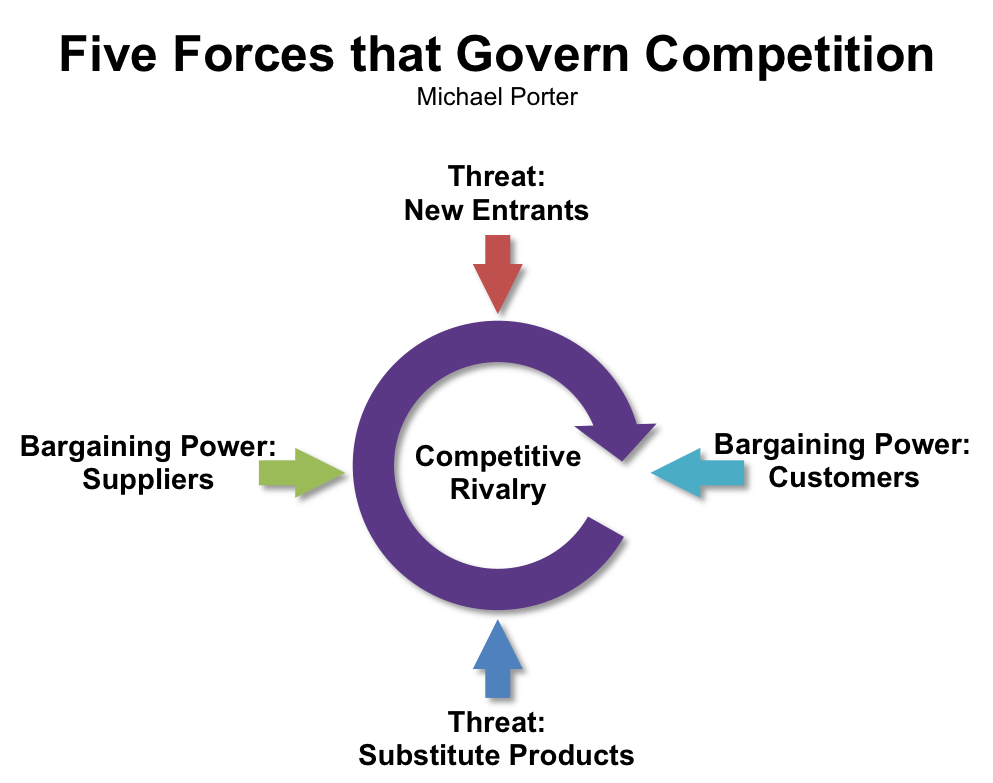Of all the strategic thinkers we have covered (like Igor Ansoff, Kenichi Ohmae, and Porter’s student, Kathryyn Rudi Harrigan), Michael Porter deserves a special place. His 1980 book, Competitive Strategy, transformed thinking, moving us from the pre-Porter world of strategic thinking dominated by Ansoff, to the post-Porter world that he still dominates.
Porter is an intellectual and an influencer who does not covet the easy quotability of some of his contemporaries. But the rigour of his analysis has made him all the more sought-after. His books have sold in the hundreds of thousands, and his speaking fees are legendary.

Short Biography
Michael Porter was born in 1947, in Michigan, and went to Princeton to study for a BSE in Aeronautical Engineering in 1969. He graduated top of his class and was inducted into the two most prestigious honor houses. He then shifted his focus to business, and went to Harvard Business School, where he received an MBA in 1971 and a PhD in Economics in 1973. From there he joined the faculty.
He remains at Harvard today, as a University Professor, and also Founding Director of Harvard Business School’s Institute for Strategy and Competitiveness, which he founded in 2001 to further his work and research.
Porter’s breakthrough came with the 1980 publication of Competitive Strategy. Other significant yet accessible books are The Competitive Advantage of Nations (1990) and the 1998 article and essay collection, On Competition. But these are among 15 other successful books and article collections.
But what you are interested in are Porter’s big ideas…
Michael Porter’s Big Ideas
Before Porter, Igor Ansoff dominated thinking on corporate strategy. His approach boiled down to choosing your market, matching your resources to meet the market’s demand, and then improving your competitiveness to increase your market share.
Michael Porter did not reject these ideas. Rather, he opened them out, approaching strategy from the perspective of the whole industry and then, later, as a national endeavour. He considered that earlier strategic thinking had become confused with simple (ahem) operational effectiveness. He argued that improving operational processes merely levelled out competitors, rather than giving them a differentiation that led to competitive advantage.
Let’s survey five big ideas that Michael Porter has given us. All remain core parts of any business education.
Primary and Secondary Activities, and the Importance of the Value Chain
Porter divided corporate activities into Primary Activities and Secondary Activities.
Primary Activities are the value chain from inbound materials to production operations, to outbound goods and their distribution, to the ‘far end of the value chain‘, marketing and sales, to customer care and after sales services. Here, Porter argued, lay the ground for competitive advantage. The key task is to integrate these into one value chain.
Secondary Activities are the business support functions, like IT, HR, Procurement, Facilities Management, and Finance. These cannot create competitive advantage They can merely enable efficiency, or act as a drag on the business.
Porter’s Five Forces
Corporations sit in a competitive environment, which creates five forces.

Porter’s current view is that a company must aim to use these forces to re-cast the rules of its industry, in its own favour.
Sources of Competitive Advantage, and the Three Competitive Strategies
Porter argued that there are two sources of competitive advantage:
- Cost – being able to sell the same products or services at a lower price than your competitors, whilst maintaining profit margins
- Differentiation – being able to offer products and services which your customers want, but that your competitors cannot (yet) offer
This leads him to his three competitive strategies:
- Cost leadership – build the capability to produce at a lower cost than anyone else
- Differentiation – find a new product or service, or enhance what you offer to make it different
- Niche focus – find a profitable niche, and dominate it
Recently, we see competitors dominating their market with a fourth strategy, based on a third source of competitive advantage: deep loyalty. How does Apple dominate? Not by offering cheaper products, certainly. Although their supply chain efficiencies mean that their margins are exceptional.
And, some would argue, not by differentiation. Whilst they often lead for a short time here, their rivals also innovate, and certainly catch up quickly. Is there much a Mac can do that a PC cannot? Is there much an iPhone can do that a Samsung cannot?
And a company with as many and varied customers as Apple cannot truly be said to serve a niche.
No, I believe the source of Apple’s current dominance is largely the loyalty of its customer base, built on historic innovation, differentiation in multiple niches, and a reputation for excellence.
Diversification
Like Ansoff before him, Porter sees diversification as a shrewd strategy that spreads a corporation’s risk. This maybe through product development, or business acquisition.
In deciding how to diversify, Porter proposes three tests:
- Does the new industry, product set, or niche offer attractive returns on investment? Is there the opportunity to build differentiation or cost leadership?
- Is the cost of entry proportionate to the likely returns? If not, the risks are too high.
- Does the acquisition or the new venture leave the parties better-off? This is basically Ansoff’s concept of synergy.
The National Competitive Environment
In The Competitive Advantage of Nations, Porter fully articulated a line of thinking that placed national conditions at the heart of corporate success. A strong home base with good infrastructure and healthy competition grows successful global companies. Porter’s Diamond Model sets out four factors that affect a nation’s industries.

Michael Porter on Competitive Strategy
An old, but excellent video of Porter describing some of his main ideas.
You might enjoy the Strategy Pocketbook
… and the following earlier Pocketblogs:
- On Competition: Five Forces
- On Competition, again: Porter’s Five Forces
- The Value Chain
- On Competition – The Far End of the Value Chain

Revered Sir,
Thanks for your detailed information including Michael E. Porter contributions to the academic and business community about the Competitive Advantage. Moreover, I enjoyed in reading Five Forces Govern Competition and Diomond Model
Factors Determine the National Advantage are currently applicable to the Corporate Sectors of both Developed and Developing Countries in the world.